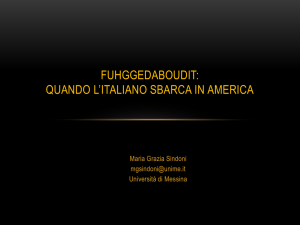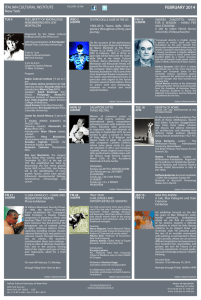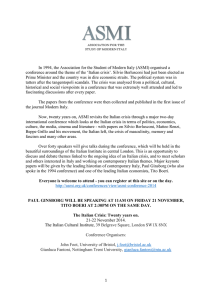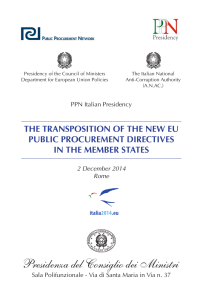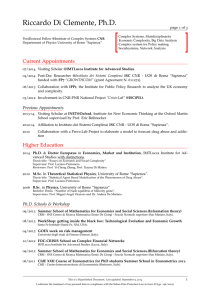CLIA 2014
advertisement
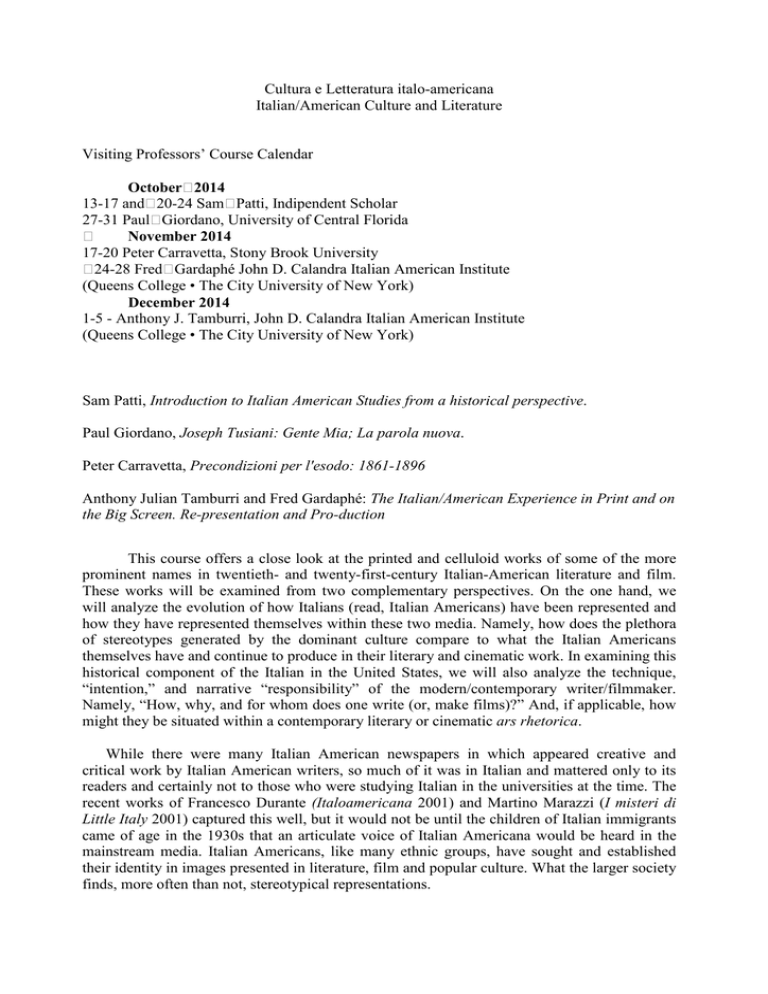
Cultura e Letteratura italo-americana Italian/American Culture and Literature Visiting Professors’ Course Calendar October 2014 13-17 and 20-24 Sam Patti, Indipendent Scholar 27-31 Paul Giordano, University of Central Florida November 2014 17-20 Peter Carravetta, Stony Brook University 24-28 Fred Gardaphé John D. Calandra Italian American Institute (Queens College • The City University of New York) December 2014 1-5 - Anthony J. Tamburri, John D. Calandra Italian American Institute (Queens College • The City University of New York) Sam Patti, Introduction to Italian American Studies from a historical perspective. Paul Giordano, Joseph Tusiani: Gente Mia; La parola nuova. Peter Carravetta, Precondizioni per l'esodo: 1861-1896 Anthony Julian Tamburri and Fred Gardaphé: The Italian/American Experience in Print and on the Big Screen. Re-presentation and Pro-duction This course offers a close look at the printed and celluloid works of some of the more prominent names in twentieth- and twenty-first-century Italian-American literature and film. These works will be examined from two complementary perspectives. On the one hand, we will analyze the evolution of how Italians (read, Italian Americans) have been represented and how they have represented themselves within these two media. Namely, how does the plethora of stereotypes generated by the dominant culture compare to what the Italian Americans themselves have and continue to produce in their literary and cinematic work. In examining this historical component of the Italian in the United States, we will also analyze the technique, “intention,” and narrative “responsibility” of the modern/contemporary writer/filmmaker. Namely, “How, why, and for whom does one write (or, make films)?” And, if applicable, how might they be situated within a contemporary literary or cinematic ars rhetorica. While there were many Italian American newspapers in which appeared creative and critical work by Italian American writers, so much of it was in Italian and mattered only to its readers and certainly not to those who were studying Italian in the universities at the time. The recent works of Francesco Durante (Italoamericana 2001) and Martino Marazzi (I misteri di Little Italy 2001) captured this well, but it would not be until the children of Italian immigrants came of age in the 1930s that an articulate voice of Italian Americana would be heard in the mainstream media. Italian Americans, like many ethnic groups, have sought and established their identity in images presented in literature, film and popular culture. What the larger society finds, more often than not, stereotypical representations. This course draws on a wealth of authentic expressions of the Italian ethnic experience in the United States to explore varieties of the Italian-American experience from immigration to ethnicity and beyond. Background lectures, discussions of readings in literature, history, and sociology and films will be utilized to bring a full range of resources to this study. The course will provide students with historical and theoretical backgrounds to become aware of the experience of Italians in America and their contributions to American culture. Course work will consist of in-class discussion of assigned readings and viewings based on field notes taken during reading, processed in small groups and presented in class. Final examination will be in the form of a 7-10 page researched essay based on course reading, developed in consultation with the instructors through written proposal, and presented orally to the class during the exam sessions. Grading will be based on class participation and performance and on written and oral assignments. READING From the Margin: Writings in Italian Americana, edited by Anthony Julian Tamburri, Paul Giordano, Fred Gardaphé, West Lafayette, Purdue University Press, 2000. La Storia: Five Centuries of the Italian American Experience, edited by Jerre Mangione and Ben Morreale, Harper Perennial, 1993. John Fante, Wait Until Spring, Bandini!, Black Sparrow, 1983. Handouts provided via .pdf files Films “Feature-length” The Godfather (Coppola, 1972. 175 min.); Mean Streets (Scorsese, 1973. 112 min.); True Love (Savoca, 1989. 104 min.); Nuovomondo (Crialese, 2006. 118 min.). Full of Life (Quine, 1956. 91 min.); Suggested Viewing Mac (Turturro, 1992. 118 min.); Big Night (Tucci, 1995. 107 min.); Dinner Rush (Giraldi, 2000. 99 min.); Pane Amaro (Norelli, 2009. 103 min.); Union Square (Savoca, 2011. 80 min.). “Shorts” (some to be viewed in class, time permitting) Like a Prayer & Justify My Love (Madonna, 1989-90); Lena’s Spaghetti (Greco, 1994 [23 min.]); Nunzio’s Second Cousin (DeCerchio, 1994 [16 min.]); Uncovering (Mariarosy Calleri, 1996 [13 min.]); Tiramisu (Guercio, 2002 [16 min.]). Recommended Criticism: Literature and Film (you may want to consult in various parts; not to purchase) • Giorgio Bertellini, Italy in Early American Cinema: Race, Landscape, and the Picturesque (Indiana University Press, 2010); available on IBS.it; • Mary Jo Bona, By the Breath of Their Mouths: Narratives of Resistance in Italian America (SUNY Press, 2011); available on IBS.it; • Jennifer Burns & Loredana Polizzi, Borderlines. Migrazioni e identità nel Novecento (Iannone, 2003); • Anna Camaiti Hostert & A. J. Tamburri, eds. Screening Ethnicity: Cinematographic Representations of Italian Americans in the United States (Bordighera Press, 2002); available on IBS.it; also available in Italian, Scene italoamericane (Sossella, 2002); • Carmine Chiellino, Parole erranti. Emigrazione, letteratura e interculturalità. Saggi 19952000 (Iannone, 2001); • Luigi Fontanella, La parola transfuga. Scrittori italiani in America (Cadmo, 2003); • Fred Gardaphé, Italian Signs, American Streets: The Evolution of Italian American Narrative (Duke University Press, 1996); available on IBS.it; • , From Wiseguys to Wise Men: The Gangster and Italian American Masculinities (Routledge, 2006); available on IBS.it; • , Segni italiani, strade americane: l’evoluzione della letteratura italiana americana (Franco Cesati Editore, 2012); available on IBS.it; • Martino Marazzi, A occhi aperti. Letteratura dell'emigrazione e mito Americano (Franco Angeli, 2011); • Giuliana Muscio, Piccole Italie grandi schermi. Scambi cinematografici tra Italia e Stati Uniti 1895-1945 (Bulzoni, 2004); • Giuliana Muscio & Giovanni Spagnoletti, a cura di, Quei bravi ragazzi. Il cinema italoamericano contemporaneo (Marsilio, 2007); • Emanuele Pettener, Nel nome del padre, del figlio, e dell'umorismo. I romanzi di John Fante (Franco Cesati Editore, 2010); • Anthony Julian Tamburri, Re-viewing Italian Americana: Generalities and Specificities on Cinema (Bordighera Press, 2011); available on IBS.it; • , Italian/American Short Films and Music Videos: A Semiotic Reading (Purdue University Press, 2002); available on IBS.it; • , A Semiotic of Ethnicity: In (Re)cognition of the Italian/American Writer (SUNY Press, 1998); available on IBS.it; also available in Italian, Una semiotica dell’etnicità (Franco Cesati Editore, 2010); • Robert Viscusi, Buried Caesars and Other Secrets of Italian American Writing (SUNY Press, 2006); available on IBS.it.
